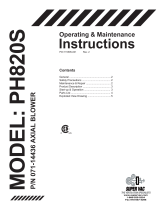Page is loading ...

ChillPAC and HeatPAC
Chiller/heat pump unit with reciprocating compressor
Installation guide EN

Installation guide - ChillPAC and HeatPAC
2/7 006616 en 2021.10
Installation guide
ChillPAC and HeatPAC units
Please note that this installation guide only describes the main issues to consider dur-
ing installation.
Further installation guidance is available in the operating manual, which must be read
carefully before operating the equipment.
Please make sure that all local and national installation and safety precautions are
observed.

Installation guide - ChillPAC and HeatPAC
006616 en 2021.10 3/7
Installation guide
Lifting instructions
Fig. 1
Before lifting the unit, make sure that straps/chains are properly secured to lifting eyes/shackles and that
the lifting equipment is in good condition. Also make sure that the lifting capacity of the crane and the
loading capacity of chains, straps, lifting eyes and shackles as a minimum correspond to the total weight
of the unit.
•When lifting the unit, please use the lifting devices on the base frame.
•It is recommended to use a yoke; this will protect the components and the insulation.
•The unit must not be lifted in the lifting devices on the compressor block and motor.

Installation guide - ChillPAC and HeatPAC
4/7 006616 en 2021.10
Installation guide
Planning the machine room
When planning the machine room, it is important to make sure there is enough space around the plant
to allow for repairs and maintenance tasks to be performed.
Fig. 2 shows the minimum required spacing.
Fig. 2
A) For operation and opening of electric panel 1100 mm
B) For withdrawing suction filter and pistons 200 mm
C) For withdrawing pistons 200 mm
D) For withdrawing crane shaft
ChillPAC 104-106-108
ChillPAC 112-116
HeatPAC 24-26-28
HeatPAC 104-106-108-704-706-708
HeatPAC 112-116-712-716
500 mm
1000 mm
400 mm
500 mm
1000 mm
The foundation must have the necessary bearing strength and be as plane as possible.

Installation guide - ChillPAC and HeatPAC
006616 en 2021.10 5/7
Installation guide
Vibration dampers
ChillPACs and HeatPACs are designed for either 4 or 6 vibration dampers. For installation on solid con-
crete floor, anti-vibration machine feet are sufficient. Such machine feet are designed for minimum 70%
vertical isolation (100% capacity).
For installation on decks, special dampers are often required. Please consult a vibration expert or a
Johnson Controls Denmark representative for further information.
To ensure optimum effect of each individual anti-vibration machine foot, the load on the feet must result
in roughly the same deflection of all machine feet, see Fig. 3. Deflection of a machine foot can be ad-
justed by increasing or reducing the load compared to the other supports by turning the adjusting rod.
Fig. 3: Anti-vibration machine foot
Other damper types can be adjusted by using liner plates.
H

Installation guide - ChillPAC and HeatPAC
6/7 006616 en 2021.10
Installation guide
Connection of pipes
Connect all piping and mount all hoses and valves for compressor cooling.
The piping design must include considerations regarding function, suspension, vibrations, thermal ex-
pansion and pre-stress after welding in order to avoid high load on the unit connections.
The safety valves are fitted on the unit from factory. The pipe connection to the valve discharge branch
must be made in accordance with valid rules/standards. External piping and condensers are not pro-
tected by the safety valves fitted on the unit.
Leak and pressure test
Leak and pressure test according to the applied/local codes and rules. Isolate the compressor unit from
the test pressure or disconnect pressure transducers and safety valves. Never exceed the test pressure
of the unit stated on the unit name plate. All ChillPAC and HeatPAC units are pressure and performance
tested from factory.
Electrical connection
Connect power supply wiring according to electrical diagrams.
Final check
Check all relevant components, connections, electrical connections, safety valves, safety high pressure
cut-out and machine room safety.
Evacuation
Evacuate the system using a vacuum pump for 5 mm Hg and perform a vacuum test.
Note: The unit is pressurised with approximately 0.5 bar (g) nitrogen from factory. The nitrogen will often
be mixed with a minor amount of R717 vapour left from the factory test (absorbed in oil). This should be
taken into account when positioning the discharge from the vacuum pump.
Charge oil
Charge oil, if not charged from factory. Oil level should be visible in the middle of the upper sight glass.
Note:
ChillPAC units can be charged with either S68 or PAO oils.
HeatPAC units may only be charged with PAO oils.

Installation guide - ChillPAC and HeatPAC
006616 en 2021.10 7/7
Installation guide
Charge refrigerant
The P&I diagram states the charge for each specific chiller or heat pump. Start out by charging 75% of
the specified R717 charge.
After start-up carefully charge more R717 until the suction superheat is between 0.5 and 3°K.
Check the liquid level in the evaporator. Droplets should come out of the top of the plates.
The plates should not be completely covered by liquid.
Note: The liquid level must never be visible in the inspection glass.
Power supply
Turn on power.
Control system
Check the UniSAB III control system settings including calibration according to the UniSAB III manual.
Motor
Check the direction of rotation of the compressor motor.
Coupling
Check alignment of coupling.
All ChillPACs and HeatPAC 104-116 and 704-716 are equipped with flange motors. Therefore, align-
ment is normally not necessary.
HeatPAC 24-26-28 are equipped with foot-mounted motors.

Johnson Controls Denmark ApS
Sabroe Factory
Christian X's Vej 201 ∙ 8270 Højbjerg
Denmark
Phone +45 87 36 70 00
www.sabroe.com
Version 2
/












